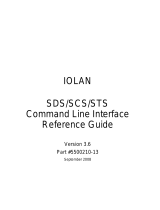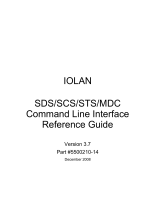
config.tp File Syntax
TruePort for Solaris User Guide 19
-pf Enables packet forwarding on the port, reading the packet forwarding
configuration from the
pktfwdcfg.tp
file. For more information see
Configuring Packet Forwarding on page 22.
Specify either
-pf
or
-opmode <mode>
, as these options are mutually
exclusive.
-io mb_ascii|
mb_rtu|
io_api
For client-initiated connections, enables I/O access for the session.
z
A serial Modbus application configured for either the ASCII or RTU
protocol will be using this port.
z
A custom serial application using the Perle I/O Access API will be
using this port.
If you did not specify the
:TCP-port
option with
-client
, the
-io
option will make the destination TCP port default to 33816 (the default
listen TCP port number of the I/O TruePort services in the IOLAN Device
Server).
-server <host> Specifies the remote host name or IP address that a connection request will
be accepted from in Server mode. The default is to accept connections
from any host. The <host> can be IPv4, IPv6, or a resolvable host name. If
specifying an IPv6 address, the address must be enclosed in square
brackets ([ ]), for example [2001:0db8:85a3:08d3:1319:8a2e:0370:7348].
-nagleoff For client-initiated connections, turn off the TCP Nagle Algorithm, which
inserts a short delay so that each character is not sent individually, but sent
in small packets instead. The default is On.
-initconnect Specifies that the TruePort host will try to connect to the Device Server
when the TruePort daemon starts, as opposed to waiting for the application
to open the serial port before initiating the connection to the Device Server.
-openwaittime
<seconds>
Specifies the maximum amount of time to wait, in seconds, for a TruePort
connection to be established before returning to an application opening the
serial port (not supported in Server-Initiated Lite Mode). You can specify
the following values:
z
-2, wait forever for the TruePort connection to come up.
z
-1, open the serial port without waiting, even if there is no network
connection, and don't give an error. Any written data is discarded if the
TruePort connection is not up.
z
0, open the serial port without waiting, and return an error (EIO) if the
TruePort connection is not up. If a network connection exists, then no
error is returned.
z
1-65535, wait up to the specified seconds for a TruePort connection to
be fully established. If a timeout occurs before a network connection is
established, an error is returned (EIO).
The TruePort connection is fully established when:
z
The TCP connection between the terminal/device server and the
TruePort host is up.
z
The SSL/TLS negotiation succeeds (if used).
z
The TruePort Full mode protocol negotiation succeeds (if used).
The range is -2 to 65535. The default is -2 (wait forever).
-closedelaytime
<seconds>
Specifies the amount of time, in seconds, to wait after an application closes
the serial port, before the TCP connection is closed to avoid bringing the
TCP connection down and up if the application is closing and opening the
COM port often. The range is 0-65535. The default is 3 seconds.
-norestorenet By default, when the network connection fails for client-initiated mode,
TruePort will attempt to restore it. If this option is specified, and the
network connection fails, there is no attempt to restore it.




























